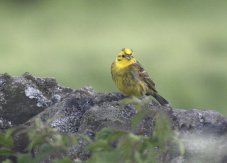Birds
The Ridgeway either side of the River Thames offers two contrasting bird habitats. The open countryside to the south west is home to Skylarks, Meadow pipits, Yellowhammers, Lapwings, Kestrels and Buzzards. The arable fields either side of the route attract Partridge, Pheasant and Quail, and a few Lapwings nest in cereal fields. Corn Buntings may be seen singing on the fences.
To the east are the well wooded Chiltern Hills with some of the finest high beech woodland in Britain. These woods are home to Tits, Great-spotted Woodpeckers and Nuthatches. Where the woods are bordered by open grassland, Green Woodpeckers may be found. Red Kites were re-introduced to the area at Aston Rowant and are now a common sight across the area, sometimes seen soaring in groups of ten plus. The woodland edges offer a greater range of shrubs and attract similar birds as hedgerows and scrub. Hedgerows are a prominent feature in parts along the whole length of The Ridgeway. They are home to Blackbirds, Jays, Tits and Chiffchaffs, and in sparse hedges and scrub, Yellowhammers and Linnets. In the denser bushes, Whitethroat, Lesser Whitethroat and Willow Warbler move in. In the tallest, thickest hedges more woodland species breed, including Blackcap, Blackbird and Dove.

MIGRATION – The open chalk escarpments of the Wessex Downs and the Chilterns form natural highways for migrating birds. Wheatears stop on the fields and gallops to feed on their journeys to and from Africa. In the scrub and hedgerows in late summer, Warblers, Flycatchers and Redstarts stop on their long journey south, especially on prominent south facing areas like Barbury Castle, White Horse Hill, Coombe Hill and Ivinghoe Beacon. Autumn sees gatherings of Finches and Buntings (especially Linnets) along the length of The Ridgeway. They feed on spilt grain from the harvest and other seeds.
In Winter, the open downland can be bleak, but large numbers of Redwings and Fieldfares arrive from their breeding areas in Scandinavia. They come to feed on hedgerow berries. The resident finches, particularly Linnets, Yellowhammers and Corn Buntings, flock together feeding along the field edges and roosting in the scrub. The winter bird flocks and small mammals are a valuable food supply for birds of prey who have bred further north and spend the winter on the downs. Merlins, Hen Harriers and Short-eared Owls join the local Sparrowhawks and Kestrels each year. In woodland in winter the seeds of the beech trees is a favourite food of Chaffinches, Greenfinches, Tits and in some years Bramblings.

GREAT BUSTARDS ON SALISBURY PLAIN
The Great Bustard is one of the heaviest flying birds in the world, and once roamed the open spaces of England. But it has been extinct here since the mid 1800s. Various unsuccessful attempts have been made to re-introduce them, but in 2004 a new population was introduced to Salisbury Plain in the care of the Great Bustard Group. Each year, young birds are brought over from the steppes of Russia, held in quarantine for about 6 weeks, then placed in an enclosed grassy area surrounded by a high wire fence, the Release Pen. They are free to fly over the fence onto the plain at large, and do so when they are ready. They can also return to the Release Pen if they wish. The survival rate has not been very high, initially due to predation by foxes, which the Bustards do not recognise as predators. The Great Bustard Group intentionally makes minimal human contact with the birds, so that they remain completely wild. Thus, it may take generations for them to acquire the necessary survival skills. But all birds are wing tagged showing the year they arrived and their number, and some birds have be fitted with a GPS for accurate tracking, but these cost £1500 each + a monthly fee. Birds raised on Salisbury Plain have been sighted some distance away. One has been seen on the Somerset Levels, living with a group of swans, and two were seen in France, one of them unfortunately killed by an overhead electric power cable. The Group does not know the whereabouts of a lot of them, or whether in fact they are still alive. However, they do know that in 2009 a female successfully fledged 2 chicks in the wild, the first breeding in Britain since 1832.
Link: www.greatbustard.org
